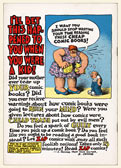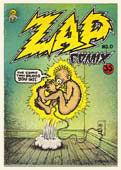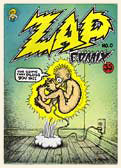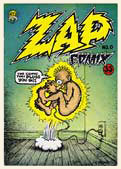|
|
|
Zap Comix #0
 |
|
 |
Back Cover
(click for larger image) |
If you like this comic,
you might
also enjoy |
 |
| R. Crumb's Comics |
| REVIEW SCORE 8 |
If you like this comic,
you might
also enjoy |
 |
Home Grown Funnies |
| REVIEW SCORE 10 |
|
4th Printing / early 1970s / 28 pages / Apex Novelties
 |
First Printing Late 1968
 |
Zap Comix #0 was published in the latter half of 1968, sometime between a few weeks and a few months after Zap Comix #2 was published in August. But if not for the fact that Brian Zahn (publisher of Yarrowstalks) had kept Crumb's artwork for Zap #0 when he traveled to India in 1968, this would have been the first book in the Zap Comix series. If it had been, would Zap Comix #0 have made the same impact that Zap #1 did when it was published? In all likelihood, yes, it would. But it would've been just a little more dicey.
Though still revolutionary for a comic book in 1968, Zap #0 is not quite as controversial as Zap #1, but it does get progressively more outrageous as you get deeper into the book. The inside front cover features Robert Crumb (as "Mr. Sketchum") introducing "Zap Comics" as "Audacious! Irreverent! Provocative!" But the first story, "Meatballs," is about as provocative as a good Mad magazine story of the same era. Sure, there's a "beatnik who was always high" in three panels, but even Mad would be bold enough to do that.
The five-page "Mr. Natural in Death Valley" that follows (see Historical Footnotes for information about new comic pages added after the first printing of the book) is a little more adventurous, as Mr. Natural advises Flakey Floont to take LSD and take a shit, which we know would never fly in any other comic. It's also a very funny story, but if all Crumb did was publish a funny comic it wouldn't have made the same impact that Zap immediately made.
The next story is "Ducks Yas Yas," a three-pager that
really exemplifies the social environment of its time, as it features a broke hippie in New York who gets high, steals shit, hitches a ride to San Francisco and drops acid for three weeks. The briskly paced story is replete with the slang and jargon of the era, though it might just as easily have been published in an underground tabloid as Zap. To some degree, that could be said about most of the comics in Zap; the comic-book format really helped Zap stand out from similar types of comics publications.
"Freak Out Funnies" is one of the more mediocre stories in the issue, but it does push the envelope as it introduces (the uncredited) Angelfood McSpade in the second half of a two-pager. Angelfood will always be controversial because she is a racist stereotype.
But it should be noted that the term "nigger" isn't used anywhere in this issue, unlike Zap #1. Not that Crumb needed to rely on that slur to create controversy, but its usage is certainly one of the elements that blew people's minds (or pissed them off) in the first issue.
Near the end of the book, the five-page "City of the Future" may be the best story in the issue, as it presents a fanciful peek at the benefits of a modern society, including "everyone will be tuned in to everything that's happening all the time!" and "fantasy machines will manufacture any world you ask for in a matter of seconds!" There will also be androids built for fucking, clocks built into your brain, and babysitting robots with TV heads, but world population control will require everyone to die at 65!
Zap Comix #0 may have been belatedly published, but overall it doesn't disappoint. The first half of the book is relatively tame, but the second half really is quite inspired, so it fits right in with the rest of the series. I don't think there's any doubt that the Zap Comix freight train would have gotten rolling if Zap #0 was the first book published, but it probably worked out for the best that it was the third issue that came out. It also gave all the comic creators working on Zap Comix #3 time to produce what would become the best issue yet in the series.



HISTORICAL FOOTNOTES:
There are 11 known printing variations of this comic book, though there are several more that cannot be distinguished from one another. Kennedy's Price Guide states there were 16 total printings by The Print Mint, totaling 280,000 copies, and that was only through 1982 (and eight identified printing variations produced by The Print Mint). Don Donahue of Apex Novelties published the first printing of 5,000 copies. The following describes the identified print variations:

1st printing - 35-cent cover price, 1/4-inch hairline mark in bottom leg of "Z" in "ZAP" on the front cover, interior pages are numbered in upper right corner (except page 17), the back cover has visible yellow ink in upper-left-corner lettering
2nd printing -
35-cent cover price, hairline mark is removed, interior pages are not numbered, yellow ink on the back cover's upper-left-corner lettering is removed
3rd printing - 35-cent cover price, the front-cover character's spine is damaged
4th printing - 35-cent cover price, front-cover character's spine is partially retouched
5th printing - 35-cent cover price, character's spine retouching is complete
6th printing
- 50-cent cover price
7th printing - 60-cent cover price
8th printing
- 75-cent cover price
9th printing
- $1.50 cover price
10th printing
- $2.50 cover price
11th printing
- $2.95 cover price

In addition, the 1st printing was 24 pages including the covers, and all subsequent issues were 28 pages. The 1st printing was produced by Don Donahue, even though The Print Mint had already taken over the title. Perhaps the Zapsters were throwing Donahue a bone after moving the title to The Print Mint, or maybe The Print Mint was just too busy to take on the small job, which was only 5,000 copies.

|
 |
 Back Cover Comparison
(click for larger image)
 |
In any case, Donahue's 1st printing was less than perfect,
with the hairline mark in the "Z" on the front cover and the misaligned and extra yellow ink on the back cover. The Print Mint took over production with the 2nd printing, which was probably at least 20,000 copies. Four pages of additional Crumb art were added to the 2nd printing to bring the book up to 28 pages, which may have seemed like the minimum number a comic book should have at the time. Since the original pages were slightly reordered to accommodate the new pages, the page numbers were removed.

The new
pages included "Sky-Hi Comics" (page 7), "Itzy and Bitzy in Cause and Effect" (page 8), "Those Cute Little Bearzy Wearzies" (page 15) and "Help Build a Better America" (inside back cover). The old inside back cover art, "Kosmic Kapers," was moved to page 14. This would remain the print order for all subsequent printings. "Sky-Hi Comics" does add a bit more provocation to the issue, as it makes references to "dropping out" and there is a racist depiction of a black person, though as in the 1st printing, the term "nigger" is not used.

The 2nd through 5th printings, which all had 35-cent cover prices, would likely not be distinguishable today if The Print Mint (or Cal Litho, which The Print Mint used as a vendor for some of its printing) had not fucked up the front cover art on the 3rd printing. Since these printings probably produced 20-40,000 copies on each press run, that turned out to be a blessing in disguise for collectors and historians.
 |
On the 3rd printing's front cover, the spine of Crumb's character was printed with minor yet easily visible damage to the black-ink printing plate. This "spine scratch" was either not noticed by the production crew or was simply overlooked. But for the 4th printing, there was an attempt to retouch the camera-ready art, which did improve the outcome but was still inferior to the undamaged printing. There was one more attempt at retouching before the 5th printing, which helped a little more, but it was still not as good as the 2nd printing.
 |
 |
 Comparison of Spine Scratches
(click for larger image) |
|
The repaired artwork on the 5th printing was used for all subsequent printings of the book. All of those later printings included cover-price changes, so they are easily distinguished from one another. But if not for the spine scratches, there would've been about 120,000 copies of 35-cent cover "3rd printings." Of course, like all old comic books, most of those would have been thrown out decades ago, but it's nice to have an easily identified timeline for these otherwise identical printings, unlike the Zap #1 35-cent cover or the Zap #2 50-cent cover.

|
Then again, it's nice to have Zap Comix #0 at all. When Crumb sent the original art for the book to Brian Zahn in 1967, and then Zahn had the audacity to head off to India without telling anything to Crumb, it would've been easy for Crumb to think the artwork had been lost forever. We're all be grateful that Crumb remembered that he had made photocopies of all of the artwork, which he typically never did, and sent those copies to William Cole in New York. Crumb got the copies back from Cole, retouched the artwork (which involved a lot more work than you might think), and Zap Comix #0 was reborn.

COMIC CREATOR:
Robert Crumb - 1-24 (1st printing), 1-28 (all other printings)
 |
 |
 |
1st Printing
Scratch in "Z", extra yellow on back. |
|
 |
 |
 |
 |
 |
 |
 |
 |
2nd Printing
No scratch in "Z", no extra yellow on back. |
3rd Printing
Spine scratch appears for first time.
|
5th Printing
Spine scratch fully repaired. |
7th Printing
60-cent cover price. |
|
|
|